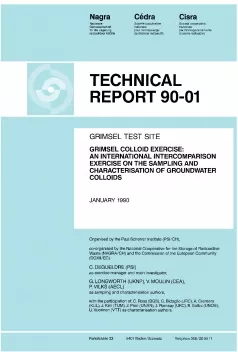
Technical Report NTB 90-01
Grimsel Test SiteGrimsel colloid exerciese:An international intercomparison exerciese on the sampling and characterisation of groundwater colloids
The Grimsel Colloid Exercise was an intercomparison project which consisted of an in-situ sampling phase followed by a colloid characterisation step. The goal of this benchmark exercise, which involved 12 laboratories, was to evaluate both sampling and characterisation techniques with emphasis on determining the colloid size distribution.
The sampling phase took place at the Grimsel Test Site between February 1 and 13, 1988 and the participating groups produced colloid samples using the following methods.
- Cross-flow ultrafiltration with production of membranes loaded with colloids:
CEA performed the separation work using a 10 ml ultrafiltration cell (constant volume of water) and colloids were separated with membranes of different pore-size.
PSI used a pulsed diaultrafiltration rig in a plastic glove-bag (purged with N2), working with 3 nm cut-off membranes and varying volume of water sample. - Tangential diaultrafiltration and production of colloid concentrates:
UKNP produced concentrated colloid samples with a hollow fibre (2.1 nm pore-size) system after prefiltration (1 μm) and used a plastic glove-bag (purged with N2) to dispense the samples.
AECL produced the concentrate with a flat membrane cassette (1.5 nm pore-size) with no prefiltration. - Filtrates produced by each group.
- Unfiltered water (28 samples of 1 l) was also collected by PSI in glass bottles, under controlled anaerobic conditions, and by the other sampling groups in various plastic bottles.
All samples were shipped to CoCo Club members for subsequent characterisation, with emphasis on size distribution determination.
While shipping and storage may affect the colloid samples, as well as the composition of both unfiltered/filtered water and concentrate samples from this somewhat demineralised water, the major element composition of the fluid samples was comparable between groups. However, air contamination decreases the pH from 9.6 to about 8, while increasing the concentration of total inorganic carbon.
The exercise differentiates the colloid samples produced on site from those obtained after transfer of the fluid samples to the laboratories. The colloid concentration and size distribution was determined by scanning electron microscopy, gravimetry, chemical analysis of fluid samples after micro/ultrafiltration and by transmission single particle counting. The colloid concentration was also evaluated by transmission electron microscopy, static and dynamic light scattering and by laser-induced photoacoustic spectroscopy.
The concentration of colloids (Ø > 10 nm) in Grimsel water is measured to be around 1014 pt.l-1 and for Ø > 50 nm about 1010 pt.l-1, although reported concentrations range over one order of magnitude between groups and according to the characterisation technique used. Particles (Ø > 450 nm) measured with scanning electron microscopy, gravimetry and transmission single particle counting appear to be around 2 × 107 pt.l-1. On a weight basis, the concentrations of colloids and particles are around 50 and 100 ppb respectively and the total particle and colloid concentration is 200 ± 100 ppb.
The colloids consist of silica, illite/muscovite, biotite, calcium silicates and organics. A population of about 106 bacteria per litre is also present. The particles are negatively charged in-situ.
The results are discussed on the basis of the detection limit, lateral resolution and counting conditions of the technique (precision) as well as sample preparation, artefact production and measurement optimisation (accuracy). A good agreement between size distribution results was obtained with electron microscopy, gravimetry and particle counting for the original samples.
The main recommendations are the need for in-situ sampling, tracking of artefact production (e.g. ion retention, aggregation ...) and identifying contamination sources during subsample production. The combination of different techniques is finally recommended in order to ensure that no interference affects colloid analysis.
